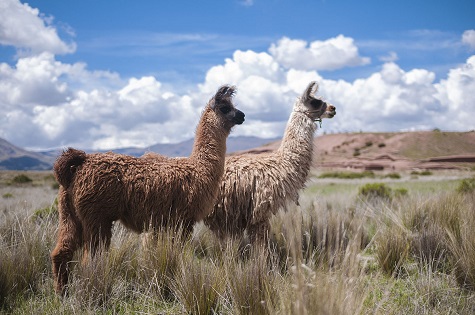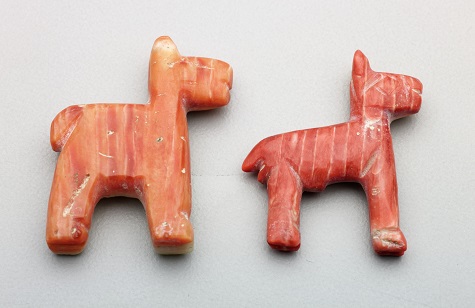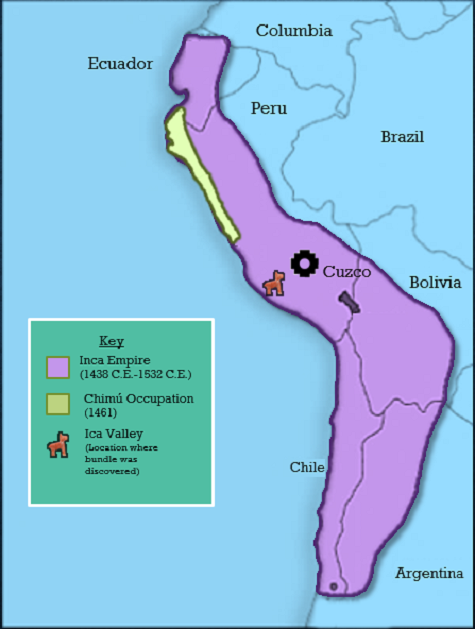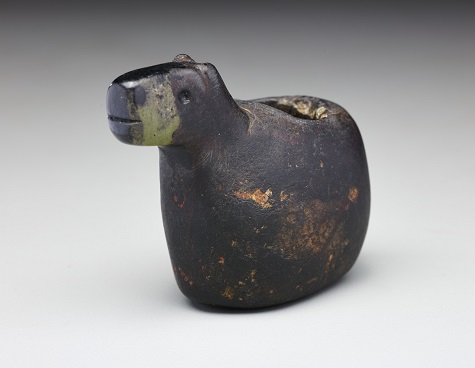In his 1551 chronicle The Discovery and Conquest of Peru, Pedro de Cieza de Leon recalled the former glory of the great Inca temple known as the Qorikancha:
There is a garden in which the earth was of pieces of fine gold, and it was sown with corn of gold, stalks as well as leaves and ears . . . more than twenty golden sheep with their lambs, and shepherds, who guarded them, their staffs and slings, were made of this metal.

South American camelids at the archaeological site of Tiahuanaco, Bolivia. image source commons.wikimedia.org : http://bit.ly/2ov0wXl
What Cieza de Leon did not realize is that these “golden sheep” were not sheep at all (sheep were introduced to South America through Spanish imperialism), but rather the most important animal within the Inca Empire: the llama.
Domesticated 6,000 to 7,000 years ago in the dry puna grasslands of Argentina, Chile, and southern Peru, llamas provided an important source of meat and of fiber used for manufacturing rope and bags in several early Andean communities. Andean artisans shaped and repurposed llama bones as tools and weaving supplies, while llama dung provided a source of fuel to heat homes. Llamas also allowed disparate cultures to interact and create trading networks by serving as the primary beasts of burden within the Andes region. Occupying the modern nations of Peru, Bolivia, Chile, Argentina, Ecuador, and Colombia, the Inca Empire (1438-1532) used llamas and llama imagery to unite their territory through trade and shared socially significant iconography.

Pair of llama figures, Peru, north coast, Inca (Inka), 1400–1550, shell, Dallas Museum of Art, The Eugene and Margaret McDermott Art Fund, Inc., 1972.23.5.1-2.McD

Our collection of Inca visual arts features several examples of llamas. These reddish-orange llamas were originally found in a Late Horizon (1400-1532) ceremonial cache on the southern coast of modern-day Peru with a variety of northern coast Chimú and southern coast Ica style feather and metalwork objects. Containing a mixture of elite items related to Chimú and Inca cultures, this bundle represents the fusion of cultures through Inca imperial expansion and trade.
Carved from the shell of a thorny oyster, or Spondylus, a mollusk imported from the tropical marine waters off Ecuador, these llama figures likely possessed multiple layers of social significance among the populations who created them. Visually, they represent the beasts of burden that enabled the extensive trade networks necessary to transport raw materials from locations that were several hundred miles away. As the inclusion of carved Spondylus shell figures in ceremonial bundles was specifically an Inca practice, these llamas may also represent South Coast groups incorporating certain aspects of Inca identity or religion into their own system of belief.

Camelid-form vessel, Peru, Inca (Inka), 1400–1540, stone, Dallas Museum of Art, collection of Andrew D. Christensen, gift of J. D. Christensen, 1983.632
Carved from a green and black stone, this ceremonial llama effigy, or illa, was used to promote agricultural and pastoral fertility in Inca communities. Inca religious leaders likely inserted a mixture of llama fat, blood, and other ceremonial objects into the hole located at the top of this vessel during various fertility rituals throughout the year. Several Inca-related groups concluded these fertility rituals by placing the illa in a pasture. Modern-day highland communities in the Andes continue to use illa during their fertility rituals to ensure the prosperity of their camelid herds.
Continue reading ‘The Emperor’s New Groove: Llama Iconography and the Inca Empire’